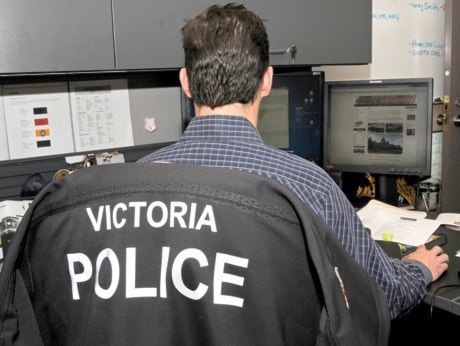Like clockwork, Det.-Const. Shawn Robson’s smartphone beeps every few minutes, alerting him to a newly arrived email in need of his attention.
Sitting at his desk in the Victoria Police Department’s intelligence section, the plainclothes officer mans two phone lines and two computer monitors connecting him to a network of contacts. This web helps him keep tabs on people living in Victoria who have committed terrible acts of violence in their pasts.
“My Blackberry doesn’t stop,” Robson says. It's indicative of the workload that comes with his job as the department’s lone high-risk offender officer.
There are upwards of 300 convicted offenders who have been released and are now living in the Capital Region, a high number for the population size, Robson says.
He monitors about 50 individuals deemed a high risk to reoffend. Some have sexually abused children and some have committed murder or other violent acts, while others have a history as prolific drug dealers.
“It’s basically the top 50 that make me lose sleep at night,” he says. “The most stressful aspects that keep me awake at night are the most violent offenders or the fellows who have committed sex offences against children and, depending where they are in their life, are at a high risk to reoffend.”
Victoria is a mecca of sorts for offenders. The city is home to three halfway houses that serve as a first stop for some people coming out of prison. That's a lot for one city, Robson says, considering there are only a handful on the entire Lower Mainland.
VicPD established its own high-risk offender unit about 10 years ago – the only one on the Island – and it is still considered relatively unique for a mid-size agency. The Vancouver Police Department has about a dozen officers to monitor their list of offenders.
Given the logistical challenge of monitoring 50 high-risk offenders, Robson relies on high-tech computer programs and threat assessment training to try and predict whether someone is going to reoffend.
Despite best efforts, offenders regularly skip town or reoffend.
Roger Badour, who had been convicted of sexual assault with a weapon, forcible confinement and uttering death threats, was under strict parole conditions when he fled Victoria.
Victoria police alerted the public in January 2011 that he posed "a risk of significant harm." Badour was eventually arrested on the mainland and subsequently charged with first-degree murder in connection with the Nov. 8, 2011 shooting death of a Princeton woman. His case is still working through the court system.
"That’s an example of a fellow, despite our best efforts, who didn’t reach out for help when he clearly knew he was struggling," said Robson, who was monitoring Badour at the time. "He fled and he was in hiding for a long time and ended up (allegedly) killing that lady. That’s a tragic event."
For authorities who monitor high-risk offenders, the Badour case was "everyone’s worst nightmare.”
To monitor such a high number of high-risk offenders, Robson works closely with fellow intelligence officers, as well as with Victoria parole and probation officers, Crown counsellors, corrections officials and several provincial ministries.
“It’s a global approach," he says. "I’m just one of many, many people and I just kind of pull everyone into the vortex.”
Often times the offenders themselves will come to Robson when they are at their breaking point.
“There’s guys who have reached a maturity level ... and they know that they are struggling, so they’ll call me or they’ll send me an email saying, ‘I need help. Things aren’t going that well.’”
Robson ensures those on his list have access to employment and housing, for example, which help offenders rebuild their lives in society after sometimes spending decades behind bars.
“If they’re stable, they’re safe, and if they’re safe, then we’re typically safe,” he says, adding that stability is helping several people on his radar live crime-free.
Kelli Moorhouse, chair of criminal justice at Camosun College, agrees that an integrated approach is necessary to support offenders as they transition back into society. She points to volunteer-based programs that pair offenders with individual mentors as the way of the future.
"We certainly can't target individuals with the anticipation that they're going to commit further offences, but if the person's volunteering, that's a different story," Moorhouse says.
"I'm a believer in restorative justice, so I think there's a lot more power when we come together as a community to help support these people."
But, for Robson, the bottom line is the community's safety.
“While I care about the offender and I want to keep him stable, I care about the community more,” he says, his words punctuated by the sound of his beeping smartphone.
“If that means put him in jail, that means put him in jail, 100 per cent.”
– with files from Daniel Palmer
